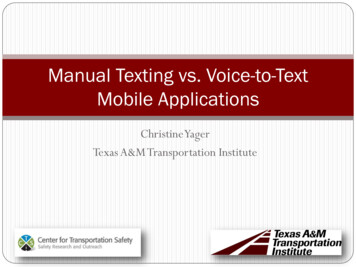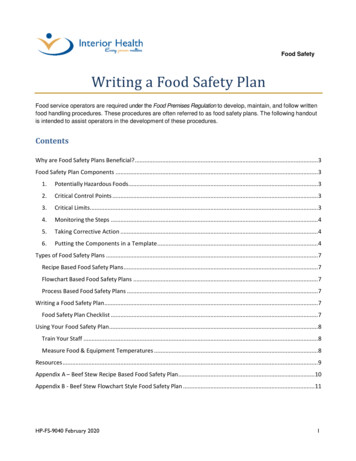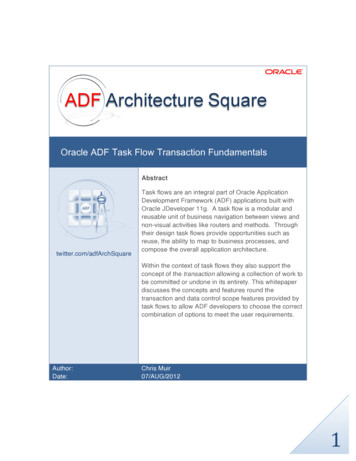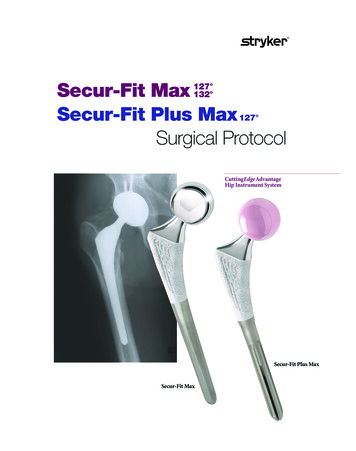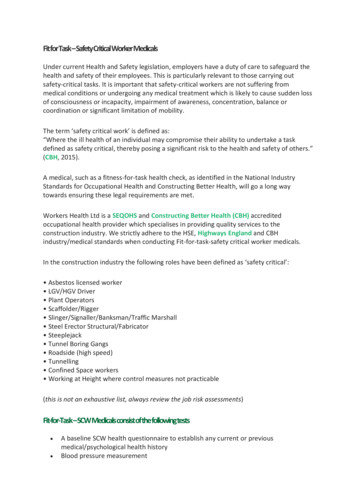
Transcription
FitforTask–SafetyCriticalWorkerMedicalsUnder current Health and Safety legislation, employers have a duty of care to safeguard thehealth and safety of their employees. This is particularly relevant to those carrying outsafety-critical tasks. It is important that safety-critical workers are not suffering frommedical conditions or undergoing any medical treatment which is likely to cause sudden lossof consciousness or incapacity, impairment of awareness, concentration, balance orcoordination or significant limitation of mobility.The term ‘safety critical work’ is defined as:“Where the ill health of an individual may compromise their ability to undertake a taskdefined as safety critical, thereby posing a significant risk to the health and safety of others.”(CBH, 2015).A medical, such as a fitness-for-task health check, as identified in the National IndustryStandards for Occupational Health and Constructing Better Health, will go a long waytowards ensuring these legal requirements are met.Workers Health Ltd is a SEQOHS and Constructing Better Health (CBH) accreditedoccupational health provider which specialises in providing quality services to theconstruction industry. We strictly adhere to the HSE, Highways England and CBHindustry/medical standards when conducting Fit-for-task-safety critical worker medicals.In the construction industry the following roles have been defined as ‘safety critical’: Asbestos licensed worker LGV/HGV Driver Plant Operators Scaffolder/Rigger Slinger/Signaller/Banksman/Traffic Marshall Steel Erector Structural/Fabricator Steeplejack Tunnel Boring Gangs Roadside (high speed) Tunnelling Confined Space workers Working at Height where control measures not practicable(this is not an exhaustive list, always review the job risk followingtests A baseline SCW health questionnaire to establish any current or previousmedical/psychological health historyBlood pressure measurement
Height, Weight & Body MassAudiometry – Hearing test, Industrial standard AudiometrySpirometry – Full Lung function testVisual Acuity, colour vision and peripheral vision screenUrinalysis for diabetes or other health issuesMuscular skeletal assessmentMental health assessment(CBH and Highways England Raising the Bar 12 standards)RECOMMENDATION FOR APPLICABILITY OF STANDARDS FOR SAFETY CRITICAL WORK TOCONSTRUCTION WORKERSThe requirement of fitness for Safety Critical Work should only be applied where it isnecessary and not used as a form of medical selection and potential disabilitydiscrimination. Where an activity was safety critical and an essential job requirement, it maybe reasonable not to employ an individual even if the Disability Discrimination Act was likelyto apply if the risk was of harm to third parties. (However legal advice should be sought tocheck this view)SUMMARY RECOMMENDATIONSGeneral Recommendations for safety critical workIt is recommended that a suitable risk assessment of any activity should identify whether ithas a safety critical nature and whether in the event of worker incapacity this would belikely to result in a significant risk of harm to the individual worker performing the task or toothers i.e. third parties.All workers undertaking safety critical work are to be examined to the above general healthstandards of safety critical work and that where individuals do not meet these standardsemployers are advised of this restriction. It may be possible to restrict an individual from“safety critical work” or the specific aspects that would be problematic. A record of thefitness standard achieved should be recorded indicating “fitness satisfactory for safetycritical work”.Where the risk associated with the activity is to the individual worker a careful explanationof these risks and consequences should be given to the worker.VISUAL ACUITY REQUIREMENTSThere are also specific visual and hearing requirements of the rail standards and theapplicability to construction workers who will not be undertaking “train working” isdiscussed below.The visual acuity of 3/60 means that someone can see at 3m distance an object that shouldbe seen at 60m distance by someone with 6/6 vision. Vision below 3/60 allows certification
for blindness i.e. the person would be considered unable to do any work for which eyesightis essential. The rail standard for visual acuity is the same as that for new entrants to Class 2driving.Colour vision is a particular requirement of the rail standards because of the need to seesignals and these are often red or green coloured. There may be trades within constructionthat require colour vision e.g. electrical and the testing of colour vision would highlight toindividuals if they may have a problem. Most tradesmen will either already be aware and /or have adapted to any difficulty.Recommendations for visual acuity standards for the construction industryIt is recommended that the Visual Acuity Standards for safety critical construction workersare the same as those for the rail standards but where individuals fail to achieve an aidedbinocular visual acuity of 6/12 it should be recognized that they may have other difficultiesin the working environment. It therefore important to determine whether they are capableof undertaking the required tasks, with or without reasonable adjustments. A record of thevision standard achieved should be recorded indicating “vision satisfactory for safety criticalwork” and any advised restrictions.It is recommended that the Colour Vision Standards for safety critical construction workersare the same as those for the rail standards. Testing colour vision would allow employers tobe aware of any colour vision deficiency and a “trade test” or practical test could be used todetermine whether in practice this a problem, thereafter making any reasonableadjustment. A record of the colour vision standard achieved should be recorded indicating“colour vision satisfactory for safety critical work” and any advised restrictions.RECOMMENDATION FOR HEARING STANDARDS FOR SAFETY CRITICAL CONSTRUCTIONWORKERSThe rail standards guidance suggests that an audiometric assessment shall be carried outand hearing loss in either ear should not exceed 30dB, averaged over frequencies of 0.5, 1and 2 kHz. Providing this requirement is met without use of a hearing aid, hearing aids maybe used to improve hearing further. No pathological condition likely to cause unpredictablefluctuation in hearing levels should be present.The rail standards are high and may not be met by a significant number of employees whohave worked in a noise-exposed environment. The Fire and Rescue Services guidancesuggests for retained firefighters that undertaking safety critical work is compatible with astandard of:(1) The sum of Low Frequency thresholds (0.5, 1 and 2 kHz) [60 dB Hearing Loss (2) The sumof High Frequency thresholds (3, 4 and 6 kHz) [80 dB Hearing Loss (3) The sum of the SpeechFrequency thresholds (1, 2, 3 kHz) [60 dB Hearing Loss and (no value 25 dB HL).Assessment to any such standards requires audiometric testing. However, audiometry atbaseline and regular intervals is required for construction workers who may be likely to be
exposed to significant noise at work (The Control of Noise at Work Regulations 2005).Therefore, occupational health providers and construction employers should have access tosuch testing and the mechanism for incorporating within health surveillance for safetycritical roles.Recommendations for hearing standards for the construction industryIt is recommended that the Hearing Standards for safety critical construction workers arethe same as those suggested for the Fire and Rescue Services Retained Firefighters standardgiven above. A record of the Hearing standard achieved should be given to the employerindicating “hearing satisfactory for safety critical work” and any advised restrictions.RE-ASSESSMENT OF FITNESS FOR SAFETY CRITICAL WORKThe rail standards guidance further requires medical assessment for safety critical workperiodically; and states that medical fitness shall be assessed and re-certificated as follows:Age at date of medical assessmentMaximum validity of certificateLess than 40 years10 yearsFrom 40 to 49 years inclusive6 yearsFrom 50 to 59 years inclusive4 years60 years and over (unless revoked earlier)2 yearsand in the event of:(1) any episode of convulsion, loss of consciousness, disturbance of consciousness ordizziness;(2) any episode of visual disturbance;(3) prescription of long term medication;(4) any incident or accident where there is reason to believe that the physical or mentalhealth of the person might have been a causal factor or adversely affected by it;(5) any other circumstances or medical condition which might impair the person’s ability tocarry out safety critical duties; whether or not the person has been absent from duty, or (6)any absence certified as being due to a psychiatric disturbance.RECOMMENDATION FOR RE-ASSESSMENT OF FITNESS FOR SAFETY CRITICAL WORK FORCONSTRUCTION WORKERSThe rail standards do not provide an evidential basis for the re-certification periods althoughthe frequency increases as age increases. Group 2 driving licenses are normally issued at age
21 and valid till age 45. Group 2 licenses are renewable thereafter every five years to age 65unless restricted to a shorter period for medical reasons. From age 65 Group 2 licenses arerenewable annually without upper age limit. The basis for the age related periodic review ofdriving fitness is informed by accident data from motor insurers. The further reasons forreviewing fitness for safety critical work under the rail standards may be summarised as,“any substantial change in medical circumstances”.Recommendations for re assessment in the construction industryIt is recommended that the standards for re assessment of fitness for safety criticalconstruction workers be set at a fixed periodic review after first assessment. Adopting sucha policy avoids any suggestion of an age discriminatory bias in an area where little objectivedata may support alternative schedules. Since audiometry is a suggested requirement ofsafety critical fitness it may be sensible to link re assessment to the 3 yearly review ofhearing that is required under the provisions of The Control of Noise at Work Regulations2005. Re assessment of fitness for safety critical construction work with any substantialchange medical circumstances also recommended. Such an assessment need only addressthe specific change in medical circumstances with full re assessment when next scheduled.DRUGS AND ALCOHOLThe rail standards have specific requirements of contractors to have established a Drug andAlcohol policy which conform to set criteria. These standards require testing for Drugs andAlcohol prior to rail working, “with cause” (in the event of an incident or accident) andrandom unannounced testing.Much of the debate (RSSB 2004) on the value of workplace drug testing appears polarisedwith some suggesting that there is good data to support the vale of testing improving safety,while others question its value. An HSL review (Beswick 2002) highlighted the paucity andlow quality of data available to answer such questions. A later study funded by HSE (RR193HSE 2004) states, “on the whole the evidence suggests that there is no systematicrelationship between drug use and workplace accidents, and it seems unlikely that workingwhilst actually under the influence of drugs is highly prevalent”. The study itself did not findan association between work place accidents and drug use. It also comments that “much ofthe existing research in this area has also found little evidence for an association betweendrug use and workplace accidents . rather work in this area more often suggests anassociation with higher absenteeism and employee turnover” (RR193 HSE 2004). However,there have been high profile incidents within construction work were drug use was involved.One of the difficulties in testing for drugs and alcohol is that only for alcohol is there a clearrelationship between the test result and the level of likely impairment. For all other drugs,the detection of parent drug or their metabolites only indicates use at some prior time andhas no significance about any impairment at the time of testing. This has led to issues aboutthe legality of such drug testing in the light of recent human rights legislation. A recent
review on workplace drug testing did conclude that current testing based on the presenceor absence of drug metabolites would not counter UK law for safety critical activities(Rowntree Foundation 2004). Functionality or impairment testing for drugs based on eyepupil responses to light stimuli are being trailed in the transportation sectors in the US andAustralia.Given the above, it is recommended that construction employers employ suitable Drugs andAlcohol policy for safety critical workersRecommendations for a drugs and alcohol policy in the construction industryIt is recommended that construction employers employ suitable Drugs and Alcohol policy.The standards for drugs and alcohol for safety critical construction workers should be thesubject of further consideration taking account of known data on such substance use in thisdemographic group, evidence from others sectors on the value of any testing and the likelyimpact of alternative approaches.VOCATIONAL DRIVINGThe Health and Safety at Work etc Act 1974 requires employers to ensure, so far as isreasonably practicable, the health and safety of all employees while at work. There is also aresponsibility to ensure that others are not put at risk by any work-related driving activities.(Self-employed people have a similar responsibility to that of employers.)Under the Management of Health and Safety at Work Regulations 1999, there is aresponsibility to manage health and safety effectively. This means there should be anassessment of the risks to the health and safety of employees, while they are at work, andto other people who may be affected by their work activities and this should be periodicallyreviewed. Although there is no legal requirement for medical assessment there is an impliedduty in ensuring a safe system of work that drivers are medically fit.Some drivers will hold class 2 driving licenses and be subject to statutory relicensing by theDVLA because of the size of vehicle driven (over 3.5 tonnes for a new license and over 7.5tonnes for those holding a current Group 1 license issued prior to 1997). There is alsospecific guidance issued by HSE in relation to lift trucks and this recommends medicalstandards for operators (HSG 6). It is suggested that fitness to hold a class 1 driving licensewill usually be sufficient but that subject to risk assessment of the work e.g. when movinghighly toxic or explosive materials, working in a particularly demanding environment,working at night, or if large, heavy trucks are to be operated. In these instances, some or allof the medical standards equivalent to that of Group 2 entitlement may be appropriate.Periodic screening for fitness is also recommended, after the age of 40 at five-yearlyintervals and annual assessments after age 65. This is a requirement above that of a class 1driving licence. Assessment is also recommended after an absence of more than one monthor after a shorter absence if it is likely that the illness may have affected fitness to operatelift trucks. The guidance specifically points out that fitness to return to work when “signedoff” by a GP may not indicate fitness to operate a lift truck.
Recommendations for vocational driving in the construction industryAs advised by INDG 382 Driving at Work Managing work related road safety employersshould develop and implement a policy on Driving at Work. This should cover drivingwhether on the public highway or on site.Where a job requires an employee to hold a driving licence (Class 1 or 2) the employershould ensure that the employee remains fit to drive for work purposes by: Monitoring absences to identify conditions that may impair drivingA requirement to cease driving in the presence of medical conditions as specified byDVLA in their at a glance guide (http: www.dvla.gov.uk/medical/ataglance.aspx)Informing staff that they should not drive, or undertake other duties, with a medicalcondition or while taking a course of medicine that might impair their control orjudgment. In cases of doubt they should seek the view of their GP or occupationalhealth provider.Where a job requires driving but the employee does not need to hold a driving licence themedical fitness guidance given in HSG 6 is recommended. Fitness to class 1 standard canusually be confirmed by the occupational health provider reviewing a suitablequestionnaire.A record of “fitness to drive at class 1 equivalent” should be given to the employer with therecommended age-related review period.
21 and valid till age 45. Group 2 licenses are renewable thereafter every five years to age 65 unless restricted to a shorter period for medical reasons. From age 65 Group 2 licenses are renewable annually without upper age limit. The basis for the age related periodic review of driving fitness



